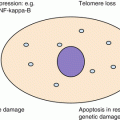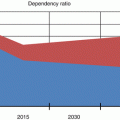Once the desire to void is generated, an older person must be able to safely navigate to the toilet. Falls in particular are a major concern in the frail elderly especially at night. Conditions affecting balance and dexterity are also likely to impact on continence.
9.4.1 Pathological Conditions Affecting the Nervous System
Dementia or strokes are examples of conditions affecting cortical control of continence. They can impair the ability to recognize the fullness of the bladder, response to urge signals and understanding socially appropriate places to void.
Detrusor sphincter dyssynergia describes the condition when there is incoordination of bladder contraction and sphincter relaxation due to abnormalities with the micturition centre or its signalling [13]. Importantly this can result in high pressures within the bladder from the obstruction to flow and poor bladder emptying. Conditions such as multiple sclerosis, cerebrovascular disease or spinal cord pathology can be the culprits.
Acute changes in bladder and bowel function including new onset incontinence should always lead to consideration of spinal cord pathology.
9.5 Assessment
The goal of assessment is to determine the factors that have led to incontinence and their reversibility. In the geriatric population, there may not be any specific bladder pathology, but managing other factors identified in the assessment can still lead to excellent results. Where possible, assessing someone in their home is often the best, allowing an insight into the patient’s environment and how they are coping. It is always important to rule out potentially sinister underlying causes first.
9.5.1 Key Areas to Focus on in History
9.5.1.1 Lower Urinary Tract Symptoms
Lower urinary tract symptoms can be non-specific, but an attempt should be made to determine to what degree the patient is suffering from urge (Do you leak or have difficulty holding on when the urge to pass urine comes on? Do you leak on the way to the toilet?) or stress incontinence (Do you leak when you cough, sneeze or perform physical tasks such as lifting or exercise?). The duration of these symptoms and their change over time should be explored. Other general questions include the frequency of toileting, the presence of hesitancy, the quality of the stream and whether they feel completely empty after voiding. Serious pathology may be present if there has been haematuria, pelvic pain, dysuria or systemic symptoms such as loss of weight or fever. A history of recurrent urinary tract infections should also be asked as this may be an indicator of poor bladder emptying, renal tract calculi or anatomical abnormalities of the urinary tract. Finally the impact of anxiety and mood disorders on bladder function needs to be explored.
9.5.1.2 Nighttime Symptoms and Nocturia
Many elderly who seek assistance with bladder control do so because of interruption to sleep with potential consequences of daytime fatigue, carer stress or falls [14, 15]. Sleep can be disturbed by nocturia or waking after an episode of nocturnal enuresis. Due to decreasing bladder capacity as we age, getting up twice at night or less may be considered normal.
A good sleep history is required to determine whether waking is due to the need to void or there is some other factor such as mental health, restless legs or poor sleep hygiene causing waking with subsequent voiding, “just in case”.
Nocturia may be due to nocturnal polyuria which is defined generally as a greater than 33% of a 24-h output occurring overnight [16]. This can be diagnosed with the aid of a bladder diary. When present, questions will need to be directed at potentially underlying causes including edematous states (e.g. congestive cardiac failure) polyuric conditions (diabetes insipidus and mellitus) or obstructive sleep apnea (affecting ADH production). Older people whose blood pressure does not fall overnight may also lead to greater urine production, but the overall relationship between blood pressure and nocturia is not entirely clear [17].
9.5.1.3 Neurological History
Questions regarding falls, balance problems or cognitive difficulties are useful to screen for possible underlying neurological conditions contributing to incontinence.
9.5.1.4 Bowels
The bowels need to be considered both specifically for their own management and also their impact on bladder continence. Physiological changes in the bowels during ageing include reduced rectal sensation and reduced external sphincter squeeze pressure [18]. Baseline questions should include the frequency and softness of the stool, whether there is any straining, and if faecal incontinence is present. Questions gauging the degree of leakage, urgency and the presence or absence of anal sensation should follow.
Recent changes in bowel habit may indicate serious underlying bowel pathology (malignancy, inflammatory conditions, etc.). Once serious pathology is excluded, often diet, fibre and fluid intake need exploring to establish their potential role in either constipation or loose stools. Constipation in particular can exacerbate urgency symptoms and reduce bladder emptying. Medications, including previous and current laxative, should be reviewed.
9.5.1.5 Obstetric and Gynaecological History
Even with older patients enquiring about the number of babies they had, birth weights, types of deliveries and whether there were any complications will help determine the potential risk for pelvic floor muscle weakness. Asking about prolapses is also important, as they are often associated with pelvic muscle weakness. The timing of menopause and previous use of hormone replacement therapy will help screen for vaginal atrophy. Previous operations for stress incontinence, IDCs or other pelvic procedures should be asked about.
9.5.1.6 Oral Intake and Weight
Many older people drink less than the recommended 1.5–3 L of fluid a day to avoid incontinence, placing them at risk of dehydration and constipation. Drinking more than this may suggest a polyuric condition. Caffeinated drinks such as coffee, tea and soft drinks can exacerbate urge and frequency. Obese patients should have their diet and motivation reviewed to determine the potential for weight loss.
9.5.1.7 Medication Review
Polypharmacy is common in the elderly, and there are many drugs that can impact on bladder or bowel function directly or indirectly. Drugs that can exacerbate urge symptoms include diuretics or cholinesterase inhibitors. Drugs that impair bladder emptying include those with anticholinergic properties such as TCADs or antipsychotics or indirectly by the multitude of drugs that lead to constipation. Any drug that can cause sedation or delirium will potentially impact on cognitive control of continence. In all cases a thorough review of these medications as to their ongoing indication or whether alternatives could be used should be explored.
9.5.1.8 Home Environment
Questions should be asked regarding the location of toilets and lighting and whether walking aids or home modifications are required to reduce the risk of falls and incontinence.
9.5.1.9 Degree of Bother
Ascertaining the degree of bother of a client’s bladder symptoms is imperative in determining the amount of investigation and management desired. How many pads or other aids an older person is using will give an idea about the degree of wetness. Questions also need to be asked about whether there is avoidance of social interaction, jobs or intimate relationships. Carers should be asked about whether they are fatigued by the burden of attending to personal hygiene or sleep deprived.
9.5.1.10 Bladder and Bowel Diaries
Diaries are an objective assessment tool that can assist with diagnosis as well as providing useful feedback to the patient about their current habits. A standard bladder diary will reveal the type and amount fluid intake, urine output with the volumes voided and frequency, as well as comments on leakage and potential triggers. Bladder diaries can help diagnose nocturnal polyuria. Ideally they should be completed over three days, and this may need assistance from carers. Bowel charts can similarly objectively determine the frequency and consistency of stool.
The arts professor’s bladder diary one month post-rehab admission
Date | Time | Fluid intake (ml) | Urine output (ml) | Comments |
|---|---|---|---|---|
8/11 | 06:00 | 100 | Wet bed | |
07:30 | Coffee 250 | |||
08:00 | 75 | |||
09:45 | 75 | |||
10:00 | Coffee 250 | |||
10:10 | 150 | Wet pad ++ on way to toilet | ||
11:00 | 100 | |||
13:00 | Coffee 250 | |||
13:15 | 50 | Wet pad +++ on way to toilet | ||
15:00 | Water 50 | 50 | ||
15:30 | Coffee 200 | |||
16:00 | 75 | |||
18:00 | Water 200 | 150 | Wet pad + on way to toilet | |
20:00 | Wine 200 | |||
22:00 | 50 | Went to bed 2300 | ||
9/11 | 01:00 | 75 | ||
02:00 | Water 50 | 10 | ||
04:00 | 50 | Wet bed on waking | ||
05:00 | 25 | |||
07:00 | 50 | Got up at 0700 | ||
Totals | 1450 | 1085 + wet pads | ||
Overnight output 210/1085 = 19% |
9.6 Examination
The important components of examination.
9.6.1 Neurological
A complete neurological examination is required with a focus on excluding:
Extrapyramidal syndromes
Spinal cord or cauda equina syndromes
Cerebrovascular disease
Autonomic neuropathies
9.6.2 Cardiovascular






